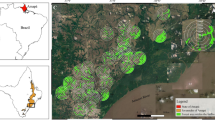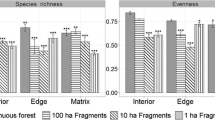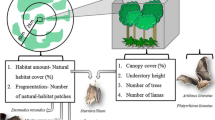Abstract
One of the key questions in ecology is to understand the mechanisms that modulate the coexistence between sympatric species. Climate and habitat perturbation gradients have been proposed as moderators of species coexistence. The first is related to availability and the diversity of food resources. The second is related to change in habitat structure that promotes changes in plant structure and diversity that impacts the diversity of other organisms. Although there is empirical evidence that supports these mechanisms to explain coexistence, they have not been evaluated quantitatively and on a wide geographic scale. Using phytophagous bat species of the genus Sturnira we evaluated both mechanisms. These bats are morphologically similar and are key organisms for the seed dispersal of Neotropical forest plants. Using systematic review protocols, we obtained data of the occurrence and relative abundance of sympatric Sturnira species of different Neotropical forests. We used generalized linear models to evaluate the predictor power of Holdridge’s life zones and habitat disturbance type to explain the evenness of sympatric Sturnira species. Life zones did not explain the variation in evenness of sympatric species of Sturnira. However, we found that the type of disturbance and individuals captured explain the variation of evenness in Sturnira species. Grasslands present the higher Sturnira species evenness, while sites with lower bat captures had higher evenness. These suggest that the reduction of vegetation complexity allows the coexistence among these highly related species, via the reduction of their relative abundances.





Similar content being viewed by others
Data availability
The datasets generated and analyzed during the current study are available in the supplementary information of the paper.
References
Barlow J, Gardner TA, Araujo IS et al (2007) Quantifying the biodiversity value of tropical primary, secondary, and plantation forests. Proc Natl Acad Sci 104:18555–18560. https://doi.org/10.1073/pnas.0703333104
Beckmann M, von Wehrden H (2012) Where you search is what you get: literature mining - Google Scholar versus web of Science using a data set from a literature search in vegetation science. J Veg Sci 23:1197–1199
Bonaccorso FJ, Winkelmann JR, Shin D et al (2007) Evidence for exploitative eompetition: comparative foraging behavior and roosting ecology of short-tailed fruit bats (Phyllostomidae). Biotropica 39:249–256. https://doi.org/10.1111/j.1744-7429.2006.00251.x
Carballo-Morales JD, Saldaña-Vazquez RA, Villalobos F (2021) Trophic guild and forest type explain phyllostomid bat abundance variation from human habitat disturbance. Glob Ecol Conserv 25:1–11
Castillo-Figueroa D (2020) Ecological morphology of neotropical bat wing structures. Zool Stud 59:1–23. https://doi.org/10.6620/ZS.2020.59-60
Chesson P (1986) Environmental variation and the coexistence of species. Community Ecol 240:54
Chesson P (2000) Mechanisms of maintenance of species diversity. Annu Rev Ecol Syst 31:343–366. https://doi.org/10.1146/annurev.ecolsys.31.1.343
Chesson P, Huntly N (1997) The roles of harsh and fluctuating conditions in the dynamics of ecological communities. Am Nat 150:519–553. https://doi.org/10.1086/286080
Clarke FM, Rostant LV, Racey P (2005) Life after logging: post-logging recovery of a neotropical bat community. J Appl Ecol 42:409–420
Clarke FM, Pio DV, Racey P (2005a) A comparison of logging systems and bat diversity in the Neotropics. Conserv Biol 19:1194–1204
Córdova-Tapia F, Zambrano L (2015) Functional diversity in community ecology. Ecosistemas 24:78–87. https://doi.org/10.7818/ecos.2015.24-3.10
Cortés-Delgado N, Sosa VJ (2014) Do bats roost and forage in shade coffee plantations? A perspective from the frugivorous bat Sturnira hondurensis. Biotropica 46:624–632. https://doi.org/10.1111/btp.12142
Crawley MJ (2007) The R Book. John Wiley & Sons Ltd
Darwin C (1859) On the origin of species by means of natural selection, or preservation of favoured races in the struggle for life. John Murray, London, UK
Díaz S, Purvis A, Cornelissen JHC et al (2013) Functional traits, the phylogeny of function, and ecosystem service vulnerability. Ecol Evol 3:2958–2975
Echeverría-Londoño S, Särkinen T, Fenton IS et al (2020) Dynamism and context‐dependency in diversification of the megadiverse plant genus Solanum (Solanaceae). J Syst Evol 58:767–782
Estrada-Villegas S, Pérez-Torres J, Stevenson P (2007) Dispersión de semillas por murciélagos en un borde de bosque montano. Ecotropicos 20:1–14
Evelyn MJ, Stiles DA (2003) Roosting requirements of two Frugivorous bats (Sturnira lilium and Arbiteus intermedius) in Fragmented Neotropical Forest. Biotropica 35:405–418. https://doi.org/10.1111/j.1744-7429.2003.tb00594.x
FAO (2012) Global ecological zones for FAO forest reporting: 2010 update. In: FAO Rome, Italy. https://www.fao.org/forest-resources-assessment/remote-sensing/global-ecological-zones-gez-mapping/en/
Fleming TH (1986) Opportunism versus specialization: the evolution of feeding strategies in frugivorous bats. In: Fleming TH, Estrada A (eds) Frugivores and seed dispersal. Dr W Junk Publishers, Dordrecht, The Netherlands, pp 105–118
Galindo-González JR, Guevara S, Sosa VJ (2000) Bat-and bird-generated seed rains at isolated trees in pastures in a tropical rainforest. Conserv Biol 14:1693–1703
García-Morales R, Chapa-Vargas L, Badano EI et al (2014) Evaluating phyllostomid bat conservation potential of three forest types in the northern neotropics of Eastern Mexico. Community Ecol 15:158–168
Garreaud RD (2009) The Andes climate and weather. Adv Geosci 22:3–11
Gentry AH (1988) Changes in plant community diversity and floristic composition on environmental and geographical gradients. Ann Missouri Bot Gard 75:1–34
Giannini NP (1999) Selection of diet and elevation by sympatric species of Sturnira in an andean rainforest. J Mammal 80:1186–1195. https://doi.org/10.2307/1383169
Halas D, Zamparo D, Brooks DR (2005) A historical biogeographical protocol for studying biotic diversification by taxon pulses. J Biogeogr 32:249–260
Hernández-Montero JR, Saldaña-Vázquez RA, Galindo-González J, Sosa VJ (2015) Bat-fruit interactions are more specialized in shaded-coffee plantations than in tropical mountain cloud forest fragments. PLoS ONE. https://doi.org/10.1371/journal.pone.0126084
Holdridge LR (1967) Life zone ecology. Tropical Science Center, San José
Hoorn C, Wesselingh FP, Ter Steege H et al (2010) Amazonia through time: andean uplift, climate change, landscape evolution, and biodiversity. Sci (80-) 330:927–931
Kneitel JM, Chase JM (2004) Trade-offs in community ecology: linking spatial scales and species coexistence. Ecol Lett. https://doi.org/10.1046/j.1461-0248.2003.00551.x
Loayza AP, Loiselle BA (2008) Preliminary information on the home range and movement patterns of Sturnira lilium (Phyllostomidae) in a naturally fragmented landscape in Bolivia. Biotropica 40:630–635. https://doi.org/10.1111/j.1744-7429.2008.00422.x
Lyons SK, Willig MR (1999) A hemispheric assessment of scale dependence in latitudinal gradients of species richness. Ecology 80:2483–2491
Macarthur R, Levins R (1967) The limiting similarity, convergence, and divergence of coexisting species. Am Nat 101:377–385
McCain CM, Grytnes J-A (2010) Elevational gradients in species richness. Encyclopedia of Life Sciences (ELS). John Wiley & Sons, Ltd, New Jersey, USA, pp 1–10
Mello MAR (2009) Temporal variation in the organization of a neotropical assemblage of leaf-nosed bats (Chiroptera: Phyllostomidae). Acta Oecol 35:280–286. https://doi.org/10.1016/j.actao.2008.11.008
Mello MAR, Kalko EKV, Rodrigues-Silva W (2008) Movements of the bat Sturnira lilium and its role as a seed disperser of Solanaceae in the Brazilian Atlantic forest. J Trop Ecol 24:225–228
Mello MAR, Marquitti FMD, Guimarães PR et al (2011) The missing part of seed dispersal networks: structure and robustness of bat-fruit interactions. PLoS ONE 6:e17395. https://doi.org/10.1371/journal.pone.0017395
Muscarella R, Fleming TH (2007) The role of frugivorous bats in tropical forest succession. Biol Rev 82:573–590
Oksanen J, Simpson GL, Blanchet FG et al (2022) Package ‘vegan.’ 1–295
Page MJ, McKenzie JE, Bossuyt PM et al (2021) The PRISMA 2020 statement: An updated guideline for reporting systematic reviews. Int J Surg. https://doi.org/10.1136/bmj.n71
R Core Team (2021) R: A language and environment for statistical computing
Ramos Pereira MJ, Palmeirim JM (2013) Latitudinal diversity gradients in new world bats: are they a consequence of niche conservatism? PLoS ONE. https://doi.org/10.1371/journal.pone.0069245
Rex K, Kelm DH, Wiesner K et al (2008) Species richness and structure of three neotropical bat assemblages. Biol J Linn Soc 94:617–629. https://doi.org/10.1111/j.1095-8312.2008.01014.x
Rocha R, López-Baucells A, Farneda FZ et al (2017) Consequences of a large-scale fragmentation experiment for neotropical bats: disentangling the relative importance of local and landscape-scale effects. Landsc Ecol 32:31–45
Saldaña-Vázquez RA (2014) Intrinsic and extrinsic factors affecting dietary specialization in Neotropical frugivorous bats. Mamm Rev. https://doi.org/10.1111/mam.12024
Saldaña-Vázquez RA, Sosa VJ, Hernández-Montero JR, López-Barrera F (2010) Abundance responses of frugivorous bats (Stenodermatinae) to coffee cultivation and selective logging practices in mountainous central Veracruz, Mexico. Biodivers Conserv 19:2111–2124. https://doi.org/10.1007/s10531-010-9829-6
Saldaña-Vázquez RA, Sosa VJ, Iñiguez-Dávalos LI, Schondube JE (2013) The role of extrinsic and intrinsic factors in neotropical fruit bat-plant interactions. J Mammal 94:632–639. https://doi.org/10.1644/11-MAMM-A-370.1
Sánchez MS, Dos Santos DA (2015) Understanding the spatial variations in the diets of two Sturnira bats (Chiroptera: Phyllostomidae) in Argentina. J Mammal 96:1352–1360
Sánchez MS, Giannini NP (2014) Altitudinal patterns in two syntopic species of Sturnira (Mammalia: Chiroptera: Phyllostomidae) in the Montane rain forests of Argentina. Biotropica 46:1–5
Sánchez MS, Giannini NP (2018) Trophic structure of frugivorous bats in the Neotropics: emergent patterns in evolutionary history. Mamm Rev 48:90–107
Sánchez MS, Carrizo LV, Giannini NP, Barquez RM (2012a) Seasonal patterns in the diet of frugivorous bats in the subtropical rainforests of Argentina. Mammalia 76:269–275. https://doi.org/10.1515/mammalia-2011-0059
Sánchez MS, Giannini NP, Barquez RM (2012b) Bat frugivory in two subtropical rain forests of Northern Argentina: testing hypotheses of fruit selection in the Neotropics. Mamm Biol 77:22–31. https://doi.org/10.1016/j.mambio.2011.06.002
Simmons NB, Cirranello AL (2022) Bat species of the world: a taxonomic and geographic database. In: Accessed June 2022. https://batnames.org/
Stevens RD (2011) Relative effects of time for speciation and tropical niche conservatism on the latitudinal diversity gradient of phyllostomid bats. Proc R Soc B Biol Sci 278:2528–2536
Tello JS, Stevens RD (2010) Multiple environmental determinants of regional species richness and effects of geographic range size. Ecography (Cop) 33:796–808
Velazco PM, Patterson BD (2013) Diversification of the Yellow-shouldered bats, Genus Sturnira (Chiroptera, Phyllostomidae), in the New World tropics. Mol Phylogenet Evol 68:683–698. https://doi.org/10.1016/j.ympev.2013.04.016
Violle C, Nemergut DR, Pu Z, Jiang L (2011) Phylogenetic limiting similarity and competitive exclusion. Ecol Lett 14:782–787. https://doi.org/10.1111/j.1461-0248.2011.01644.x
Wiens JJ (2012) Perspective: why biogeography matters: historical biogeography vs. phylogeography and community phylogenetics for inferring ecological and evolutionary processes. Front Biogeogr 4
Wiens JJ, Donoghue MJ (2004) Historical biogeography, ecology and species richness. Trends Ecol Evol 19:639–644
Willig MR, Bloch CP (2006) Latitudinal gradients of species richness: a test of the geographic area hypothesis at two ecological scales. Oikos 112:163–173
Willig MR, Kaufman DM, Stevens RD (2003) Latitudinal gradients of Biodiversity: pattern, process, Scale, and synthesis. Annu Rev Ecol Evol Syst 34:273–309
Wright SJ (2002) Plant diversity in tropical forests: a review of mechanisms of species coexistence. Oecologia 130:1–14. https://doi.org/10.1007/s004420100809
Zobel M (1997) The relative role of species pools in determining plant species richness: an alternative explanation of species coexistence? Trends Ecol Evol 12:266–269. https://doi.org/10.1016/S0169-5347(97)01096-3
Acknowledgements
We thank the Pontificia Universidad Javeriana Cali for the facilities granted to E. Mosquera-Izquierdo to carry out this work as part of his professional practices. Likewise, to the Environmental Research Institute of the Universidad Iberoamericana Puebla for the facilities for E. Mosquera-Izquierdo’s internship.
Funding
The authors declare that no funds, grants, or other support were received during the preparation of this manuscript.
Author information
Authors and Affiliations
Contributions
All authors contributed to the study conception and design. Material preparation and analysis were performed by EMI and RASV. Data compilation were performed by EMI, MSS and RASV. The first draft of the manuscript was written by EMI, MSS, FV and RASV and all authors commented on previous versions of the manuscript. All authors read and approved the final manuscript.
Corresponding author
Ethics declarations
Competing interests
The authors declare no competing interests.
Additional information
Communicated by Roberto Cazzolla Gatti.
Publisher’s note
Springer Nature remains neutral with regard to jurisdictional claims in published maps and institutional affiliations.
Supplementary Information
Below is the link to the electronic supplementary material.
Rights and permissions
Springer Nature or its licensor (e.g. a society or other partner) holds exclusive rights to this article under a publishing agreement with the author(s) or other rightsholder(s); author self-archiving of the accepted manuscript version of this article is solely governed by the terms of such publishing agreement and applicable law.
About this article
Cite this article
Mosquera-Izquierdo, E., Saldaña-Vázquez, R.A., Sánchez, M.S. et al. Evaluating the macro and micro geographic mechanisms that modulate the coexistence between sympatric Sturnira bat species. Biodivers Conserv 32, 4509–4523 (2023). https://doi.org/10.1007/s10531-023-02712-w
Received:
Revised:
Accepted:
Published:
Issue Date:
DOI: https://doi.org/10.1007/s10531-023-02712-w




